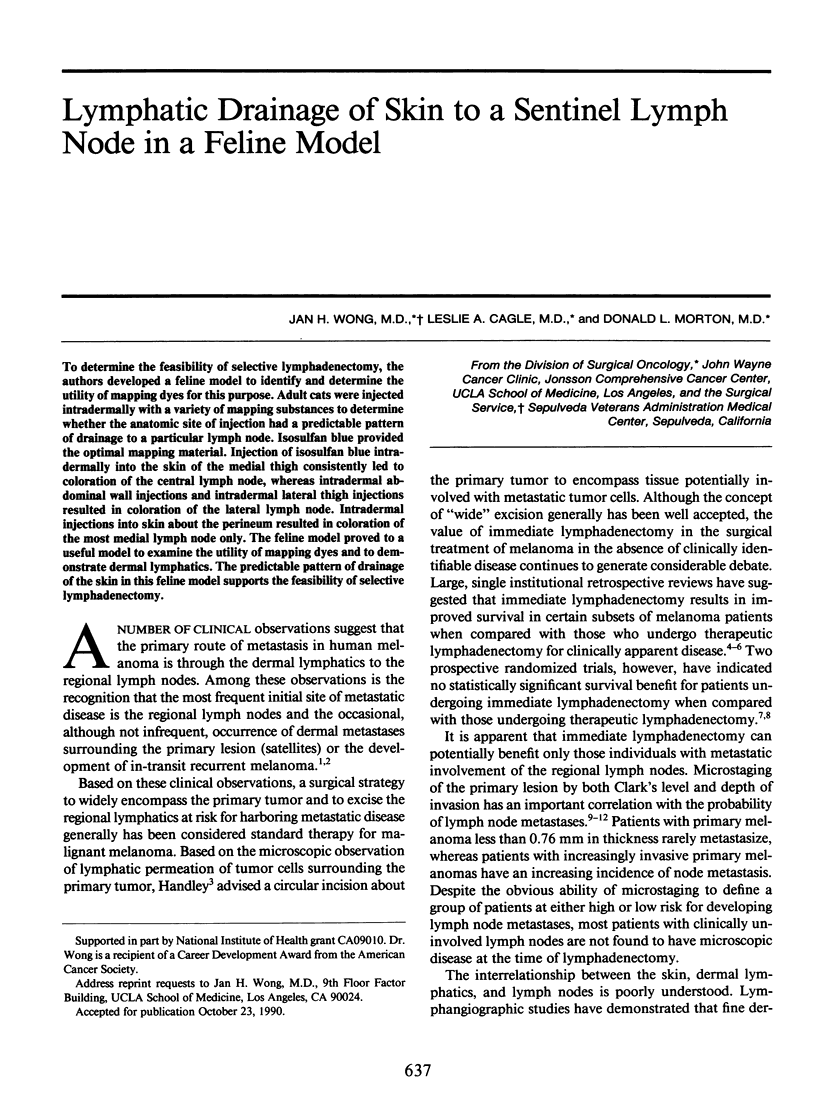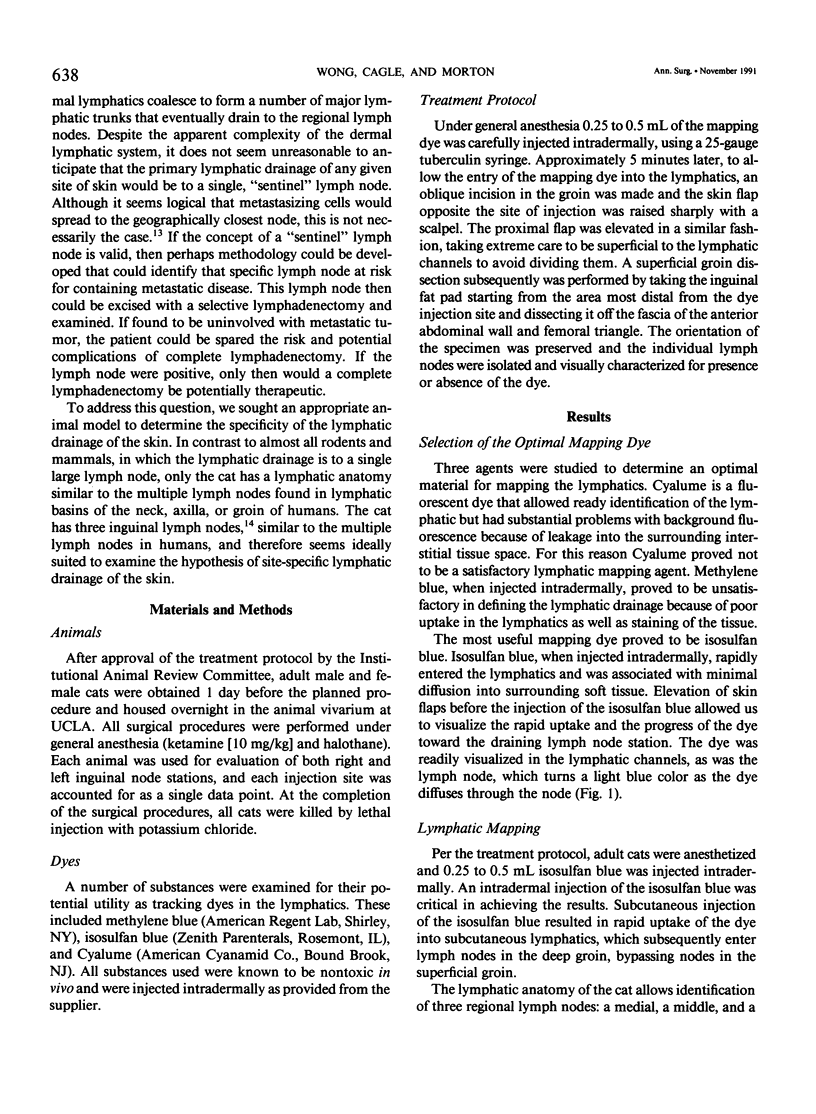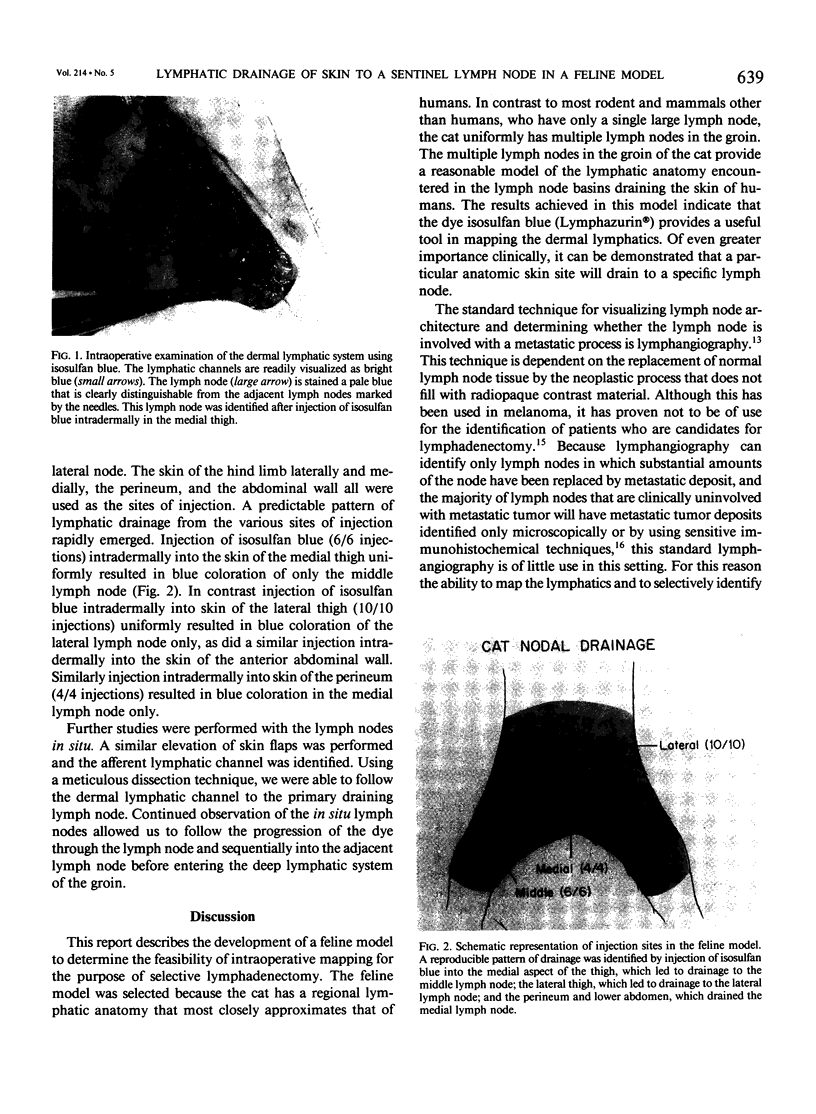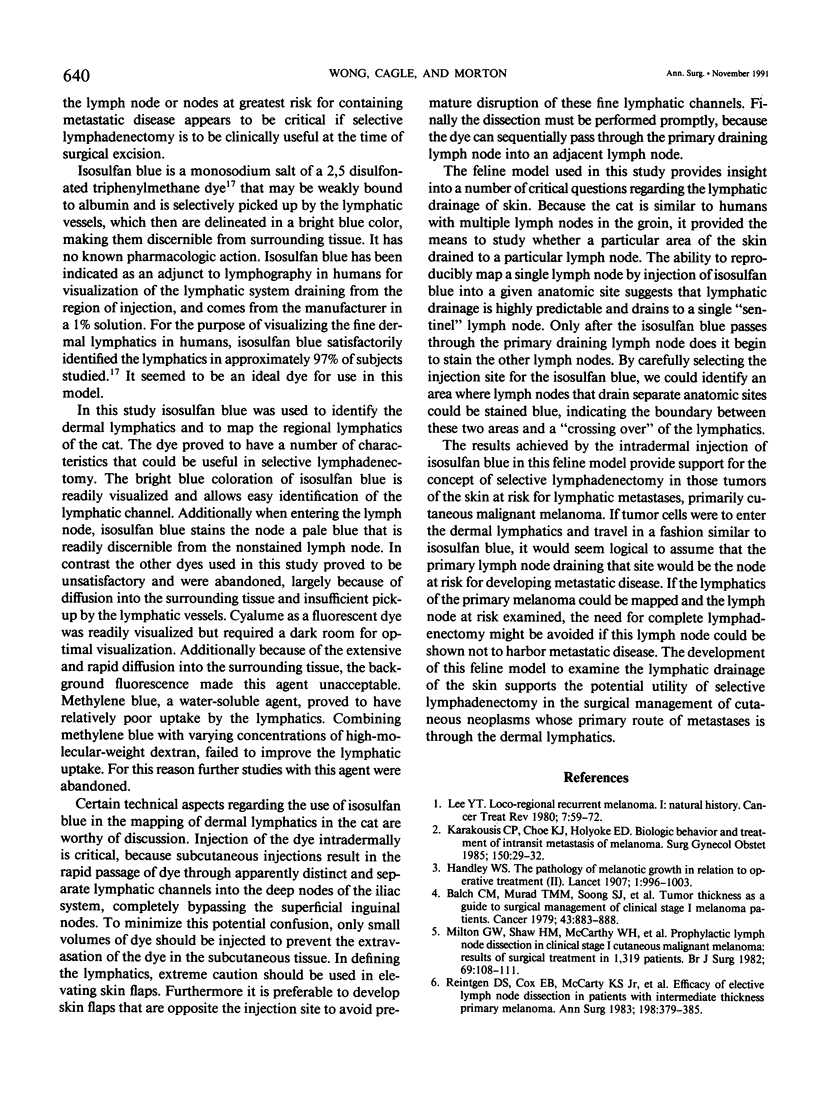Abstract
To determine the feasibility of selective lymphadenectomy, the authors developed a feline model to identify and determine the utility of mapping dyes for this purpose. Adult cats were injected intradermally with a variety of mapping substances to determine whether the anatomic site of injection had a predictable pattern of drainage to a particular lymph node. Isosulfan blue provided the optimal mapping material. Injection of isosulfan blue intradermally into the skin of the medial thigh consistently led to coloration of the central lymph node, whereas intradermal abdominal wall injections and intradermal lateral thigh injections resulted in coloration of the lateral lymph node. Intradermal injections into skin about the perineum resulted in coloration of the most medial lymph node only. The feline model proved to a useful model to examine the utility of mapping dyes and to demonstrate dermal lymphatics. The predictable pattern of drainage of the skin in this feline model supports the feasibility of selective lymphadenectomy.
Full text
PDF




Images in this article
Selected References
These references are in PubMed. This may not be the complete list of references from this article.
- Balch C. M., Murad T. M., Soong S. J., Ingalls A. L., Richards P. C., Maddox W. A. Tumor thickness as a guide to surgical management of clinical stage I melanoma patients. Cancer. 1979 Mar;43(3):883–888. doi: 10.1002/1097-0142(197903)43:3<883::aid-cncr2820430316>3.0.co;2-v. [DOI] [PubMed] [Google Scholar]
- Breslow A. Tumor thickness, level of invasion and node dissection in stage I cutaneous melanoma. Ann Surg. 1975 Nov;182(5):572–575. doi: 10.1097/00000658-197511000-00007. [DOI] [PMC free article] [PubMed] [Google Scholar]
- Cochran A. J., Wen D. R., Morton D. L. Occult tumor cells in the lymph nodes of patients with pathological stage I malignant melanoma. An immunohistological study. Am J Surg Pathol. 1988 Aug;12(8):612–618. doi: 10.1097/00000478-198808000-00002. [DOI] [PubMed] [Google Scholar]
- Cox K. R., Hare W. S., Bruce P. T. Lymphography in melanoma. Correlation of radiology with pathology. Cancer. 1966 May;19(5):637–647. doi: 10.1002/1097-0142(196605)19:5<637::aid-cncr2820190507>3.0.co;2-r. [DOI] [PubMed] [Google Scholar]
- Gupta T. K. Results of treatment of 269 patients with primary cutaneous melanoma: a five-year prospective study. Ann Surg. 1977 Aug;186(2):201–209. doi: 10.1097/00000658-197708000-00013. [DOI] [PMC free article] [PubMed] [Google Scholar]
- Hirsch J. I., Tisnado J., Cho S. R., Beachley M. C. Use of isosulfan blue for identification of lymphatic vessels: experimental and clinical evaluation. AJR Am J Roentgenol. 1982 Dec;139(6):1061–1064. doi: 10.2214/ajr.139.6.1061. [DOI] [PubMed] [Google Scholar]
- Holmes E. C., Moseley H. S., Morton D. L., Clark W., Robinson D., Urist M. M. A rational approach to the surgical management of melanoma. Ann Surg. 1977 Oct;186(4):481–490. doi: 10.1097/00000658-197710000-00010. [DOI] [PMC free article] [PubMed] [Google Scholar]
- Karakousis C. P., Choe K. J., Holyoke E. D. Biologic behavior and treatment of intransit metastasis of melanoma. Surg Gynecol Obstet. 1980 Jan;150(1):29–32. [PubMed] [Google Scholar]
- Lee Y. T. Loco-regional recurrent melanoma: I natural history. Cancer Treat Rev. 1980 Jun;7(2):59–72. doi: 10.1016/s0305-7372(80)80016-8. [DOI] [PubMed] [Google Scholar]
- Milton G. W., Shaw H. M., McCarthy W. H., Pearson L., Balch C. M., Soong S. J. Prophylactic lymph node dissection in clinical stage I cutaneous malignant melanoma: results of surgical treatment in 1319 patients. Br J Surg. 1982 Feb;69(2):108–111. doi: 10.1002/bjs.1800690217. [DOI] [PubMed] [Google Scholar]
- Reintgen D. S., Cox E. B., McCarty K. S., Jr, Vollmer R. T., Seigler H. F. Efficacy of elective lymph node dissection in patients with intermediate thickness primary melanoma. Ann Surg. 1983 Sep;198(3):379–385. doi: 10.1097/00000658-198309000-00014. [DOI] [PMC free article] [PubMed] [Google Scholar]
- Sim F. H., Taylor W. F., Ivins J. C., Pritchard D. J., Soule E. H. A prospective randomized study of the efficacy of routine elective lymphadenectomy in management of malignant melanoma. Preliminary results. Cancer. 1978 Mar;41(3):948–956. doi: 10.1002/1097-0142(197803)41:3<948::aid-cncr2820410324>3.0.co;2-z. [DOI] [PubMed] [Google Scholar]
- Veronesi U., Adamus J., Bandiera D. C., Brennhovd O., Caceres E., Cascinelli N., Claudio F., Ikonopisov R. L., Javorski V. V., Kirov S. Delayed regional lymph node dissection in stage I melanoma of the skin of the lower extremities. Cancer. 1982 Jun 1;49(11):2420–2430. doi: 10.1002/1097-0142(19820601)49:11<2420::aid-cncr2820491133>3.0.co;2-2. [DOI] [PubMed] [Google Scholar]
- Wanebo H. J., Woodruff J., Fortner J. G. Malignant melanoma of the extremities: a clinicopathologic study using levels of invasion (microstage). Cancer. 1975 Mar;35(3):666–676. doi: 10.1002/1097-0142(197503)35:3<666::aid-cncr2820350320>3.0.co;2-4. [DOI] [PubMed] [Google Scholar]




